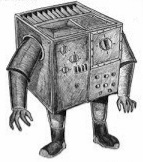|
To save a bunch of gas mostly. Turboprops are are considerably more efficient than turbojets at low and moderate altitudes. The downside is that your efficiency drops off considerably at higher altitudes and it's not practical to go above 500 knots or so. Of course you can combine some of the best aspects of the Turboprop and the Turbojet to get the Turbofan, which is what pretty much all airliners use. Turboprops are still more efficient for small commuter aircraft though, since they never get up to the altitude where Turbofans really start to win out on fuel efficiency. As to why they don't just use older style reciprocating engines, the answer is that Turboprops have fewer parts and less required maintenance, so they're cheaper to operate over the long run (even if they do cost more up front).
|
|
|
|

|
| # ? Apr 18, 2024 19:02 |
|
2ndclasscitizen posted:What's the idea behind a turboprop anyway? Why go to the effort of fitting a jet engine to a plane, and then have it spin a propeller rather than move the plane itself? For example, take the Rolls Royce Trent 800 on Boeing 777s. HUGE engine, right? MASSIVE! But if you look closely, you can see daylight through it- despite outward appearances, those giant blades are functioning much like a propeller, albeit one that's far more efficient and works at speeds much closer to mach 1.  There are other twists on the turboprop, too: 
grover fucked around with this message at 03:01 on Jun 23, 2010 |
|
|
|
2ndclasscitizen posted:What's the idea behind a turboprop anyway? Why go to the effort of fitting a jet engine to a plane, and then have it spin a propeller rather than move the plane itself? turbojet - the simplest jet engine, all thrust comes from the combustion exhaust turbofan - combustion exhaust spins a big shrouded fan and most air bypasses the hot section turboprop - combustion exhaust spins a propeller (big unshrouded fan) and most air bypasses the hot section turboshaft - combustion exhaust spins a shaft that goes to some other drive mechanism, such as the rear axle of a Chrysler minivan Basically, turbojets emit a lot of energy as noise and really fast exhaust. However, fast exhaust isn't really great for propulsion and noise is loving obnoxious if you live within ten miles of an airport. Turbofans slow the exhaust down, use that energy to move a greater mass of air at a more modest speed for subsonic flight. This means they can burn less fuel, allowing them to carry more poo poo, go farther, and you to buy airplane rides for less than $500. Turboprops are efficient at lower speeds, which for light loads makes more economic sense, because going slower in a smaller airplane is very cheap aerodynamically. (caveat: I'm aerospergin', but not an actual mechanical or aeronautical engineer)
|
|
|
|
BonzoESC posted:Some definitions: I'm curious. On a turbofan, whats the typical ratio of air that passes through the fan rather than the combustion chamber?
|
|
|
|
Minto Took posted:I'm curious. On a turbofan, whats the typical ratio of air that passes through the fan rather than the combustion chamber? The JT8D on 737 Classics has a pretty low ratio of less than 2 (for each mass unit of air that goes through the hot section, two go through the bypass). The CFM-56 on 737 Next Generations and ugly French knockoffs have a ratio over 5. The GE90 on the 777 has a ratio of about 11.
|
|
|
|
Here, have some wikipedia articles: http://en.wikipedia.org/wiki/Bypass_ratio http://en.wikipedia.org/wiki/CFM_International_CFM56#CFM56-7_series http://en.wikipedia.org/wiki/Pratt_%26_Whitney_JT8D http://en.wikipedia.org/wiki/Dodge_Caravan#Generation_III_.281996.E2.80.932000.29
|
|
|
|
The Soviets must not have been particularly pleased with the names NATO gave their aircraft; Frogfoot, Fagot, Fiddler, Fargo etc... 1960's Soviet bomber pilot: "Yay, I get to fly in a plane called the 'Backfire'"
|
|
|
|
KlementGottwald posted:The Soviets must not have been particularly pleased with the names NATO gave their aircraft; Frogfoot, Fagot, Fiddler, Fargo etc...
|
|
|
|
Jimmy Smuts posted:"Bear", "Freestyle", "Foxhound", and "Flanker" make up for those. Though it's too bad the Freestyle went nowhere. I wish they had even cooler stuff like "TankTop" and "Dropkick". T-87c Booyah. Mi-62 Lolcat.
|
|
|
|
Jimmy Smuts posted:"Bear", "Freestyle", "Foxhound", and "Flanker" make up for those. Though it's too bad the Freestyle went nowhere. Cock and human being would like to have a word with you.
|
|
|
|
KlementGottwald posted:The Soviets must not have been particularly pleased with the names NATO gave their aircraft Jimmy Smuts posted:"Bear"... make up for those. Question: How do you start a rotary (Clerget, not Wankel) engine? I know you've got the mechanical-era equivalent of a squire out front cranking the thing over by hand, but what's the procedure inside the cockpit? As much detail as possible, please. I've been asked about this, and I'm not sure. I know the startup procedure for a WWII-era radial down to the number of blades you count going by in each step, but the Great War engines are beyond my knowledge (and probably far simpler). Chillbro Baggins fucked around with this message at 05:13 on Jun 23, 2010 |
|
|
|
Delivery McGee posted:
I already posted this, but this is the best video I can find on rotary engines. It's not going to answer your question, but it has a lot of neat information. http://www.youtube.com/watch?v=j6PnKUEFX8g EDIT: about a minute in, the unbelievably interesting pilot starts talking about the engine itself. There is definitely something interesting going on inside the cockpit, as the pilot is obviously paying quite a bit of attention to whatever gauges are in the cockpit, and making the 'squire' push the propeller forward and back. ursa_minor fucked around with this message at 05:20 on Jun 23, 2010 |
|
|
|
jandrese posted:As to why they don't just use older style reciprocating engines, the answer is that Turboprops have fewer parts and less required maintenance, so they're cheaper to operate over the long run (even if they do cost more up front). Turbine engines also have a huge power/weight advantage over reciprocating engines, in addition to being far more reliable. The Pratt and Whitney R-4360 produced 4,300hp by the end of development, but weighed almost 3,900lbs, which meant it's power/weight ratio was only slightly higher than 1/1. Most turboprops have power/weight ratios in excess of 2/1, and do so without the vibration or reliability issues of piston engines. As an example, the 28 cylinder R-4360 used two spark plugs per cylinder (56 per engine), and each engine used both a turbocharger and supercharger along with reduction gearing for the propeller, which made them less than simple to maintain. Even when running properly, a large radial still required a ton of maintenance, with engines in commercial service requiring a total overhaul about every 600 hours. By contrast, a modern turbine engine might get inspected every few hundred hours, but will last thousands of flight hours in normal service before needing a replacement or major overhaul.
|
|
|
|
Just scanned this in tonight - my wife got it at a small WWII airshow years ago. Sat and talked with him for a good while, too.
|
|
|
|
ed: Uh whoops, that's probably This is a fantastic book about jet engines for anyone interested http://www.amazon.com/Jet-Engine-Rolls-Royce/dp/0902121235/ref=sr_1_1?ie=UTF8&s=books&qid=1277286902&sr=8-1 jacteh fucked around with this message at 10:57 on Jun 23, 2010 |
|
|
|
ursa_minor posted:I already posted this, but this is the best video I can find on rotary engines. It's not going to answer your question, but it has a lot of neat information. Pretty different than how airliners start: http://www.youtube.com/watch?v=8z0eW9fbrG0
|
|
|
|
grover posted:None whatsoever. (Hence why we don't see any forward-swept fighters, vaporware russian fighters aside.) Would be awesome at air shows, though, wouldn't it? The high speed characteristics are actually really good, but its matchable with thrust vectoring, at a higher cost. But front swept is a complete bitch to land because your speed and angle of decent have to be dead on to be controllable while in ground effect
|
|
|
|
River Raid posted:The high speed characteristics are actually really good, but its matchable with thrust vectoring, at a higher cost. But front swept is a complete bitch to land because your speed and angle of decent have to be dead on to be controllable while in ground effect i only know about stickin fingers into ladies but river raid is a name you can trust when it comes to backwards wings
|
|
|
|
All I gotta say really is one word. Compound. http://en.wikipedia.org/wiki/Wright_R-3350 Something tells me power recovery methods are going to become fairly commonplace as we try to squeeze more power from our engines.
|
|
|
|
ursa_minor posted:I already posted this, but this is the best video I can find on rotary engines. It's not going to answer your question, but it has a lot of neat information.
|
|
|
|
https://www.youtube.com/watch?v=5CB27K-wIsM Holy poo poo that was close. Edit: Just noticed this is a few weeks old but don't think it was posted here before?
|
|
|
|
If it was, I missed it too. My reaction wasn't too different from his wife's. Yikes.
|
|
|
|
Manny posted:https://www.youtube.com/watch?v=5CB27K-wIsM Yea Matt Hall is a fricken pilot god with spiderman's reflexes.
|
|
|
|
I'm pretty sure this wasn't posted, but if it was... damnnn this guy is lucky. 26 Turn Flat Spin in a Tipsy Nipper http://www.youtube.com/watch?v=bvbS-oHi9ro Having an accident and totaling the plane under my belt, this makes my back hurt just watching. How has someone with that much experience, as described in the comments, never heard the protocol for a power off stall that turns flat? Just watching I wanted to neutralize the ailerons, apply hard left rudder, pitch down, and lean forward. Perhaps his COG was too far back, being in a small rear end edit: The plane has a 1400-1500cc engine. No way would that balance out the load on the horizontal stabilizer with a pilot far back. I was working on my vfr, and the instructor even brought it up around hour 10-15 about what to do during if the spin you enter goes flat. Although, we are both pretty much airplane geeks, and we always had plenty of time to talk flying out to the practice area NE of a field in the Dallas Metroplex in a slow rear end Cessna. edit2:VV I found the pilots comments posted on the tipsynipper forum. Seems like I was right about the COG Neil from tippsynipper.com posted:I am in "correspondance" with the AAIB, so cannot say too much now, except: edit3:Why would you try an aerobatic maneuver in this little, underpowered thing to begin with? 
Entone fucked around with this message at 12:28 on Jun 24, 2010 |
|
|
|
I seem to recall reading that the Tipsy Nipper is really prone to flat spins and is near unrecoverable once in one. I remember seeing that video a while back, it's pretty
|
|
|
|
It is an aerobatic plane with full inverted fuel/oil systems. I talked a bit with the pilot on youtube and if you read through the comments he explains himself very well. Seems like a top guy as opposed to the masses of twats in the comments. Here's a video with his explanation: https://www.youtube.com/watch?v=TT1QGG1510w
|
|
|
|
kill me now posted:I went to the red bull air race in NY on Sunday. I flew into NYC last Thursday. I learned that the races were taking place from American's in-flight mag whilst flying out Sunday morning. Your avatar and username combo mirrored my feelings exactly. 
|
|
|
|
Ola posted:It is an aerobatic plane with full inverted fuel/oil systems. I talked a bit with the pilot on youtube and if you read through the comments he explains himself very well. Seems like a top guy as opposed to the masses of twats in the comments. Even with his explanation, I don't think I quite understand why normal spin recovery techniques didn't work at first. He mentions the ailerons being the only loaded control surfaces (albeit slightly) during the spin, when normally it's the rudder that kicks you out of the unwanted rotation. Any more experienced pilots that could further explain this? One of my favorite videos though, that man does a great job of keeping his cool and solving the problem.
|
|
|
|
I seem to recall that he really calmly says 'Well, looks like that's it then' a few seconds before he recovers it. Kind of surprising how a pilot can become so locked into flying the plane that their obvious fear of iminent death is a quiet and frank statement.
|
|
|
|
I went and collected my ebay purchase, the impulse buy RAF Hunter drop tank, swung by dads work and pop riveted it together for now to work out what I want to do with it.      I pop riveted it solely so it cant fit in my van and has to be strapped to the roof for the 200 mile drive home. Construction wise, it wasn't designed with an internal bladder like some drop tanks, originally there was a rubber seal around each join and the tank was filled directly. There and inlet and outlet on the top, a metal 'loop' that attaches to the plane and a locator nipple. Simple electrical connector and a screw filler cap. Not much else too it really. Oh and lots and lots of spiders. Any tips for filling those holes? blambert fucked around with this message at 15:00 on Jun 25, 2010 |
|
|
|
The Ferret King posted:Even with his explanation, I don't think I quite understand why normal spin recovery techniques didn't work at first. He mentions the ailerons being the only loaded control surfaces (albeit slightly) during the spin, when normally it's the rudder that kicks you out of the unwanted rotation. For the elevators, again hand out the window of your car, this time pointed into the wind. When you twist your wrist you get no effect. That's all the leading elevator could do. The trailing elevator was in the wind shadow of the rudder. the rudder is mostly an extention of a very tall fuselage. And in the spin you're just cutting a wide wake in the air, not pushing it along the body. Therefore you're getting little (or as his control feel indicated) no airflow across the rudder. This also meant the rudder was ineffective. Now in the spin, the wintips were sticking out in to clean-ish air. So they still did have some useful airflow across them. That's why his ailerons had some stick feel. And why they were useful in recovering the plane.
|
|
|
|
Nerobro posted:Now in the spin, the wintips were sticking out in to clean-ish air. So they still did have some useful airflow across them. That's why his ailerons had some stick feel. And why they were useful in recovering the plane.
|
|
|
|
grover posted:He had the presence of mind to realize they were not acting as roll control anymore, but that the drag from using them was useful in yaw control and slowing the spin. I can't believe how calm the guy was, I think I'd be freaking out! Sitting here, calmly thinking about it. It's a logical solution. You've got one wing going forward, the other going backwards. Instead of making differential lift, you'd get all lift, or all downforce from the way ailerons are setup. At least in a spin. I'm mighty impressed.
|
|
|
|
blambert posted:I went and collected my ebay purchase, the impulse buy RAF Hunter drop tank, swung by dads work and pop riveted it together for now to work out what I want to do with it. What was Dustin Hoffman doing there?
|
|
|
|
Our head quality inspector came back from holiday this week. Apparently, on the takeoff for his return flight, one of the engines ate a few seagulls, and proceeded to make a rather loud bang as it lost a few compressor blades. They made what was described as a sphincter-tighteningly low banked turn over the sea and landed again, but he couldn't get any photos of the carnage because the powers that be were being all Apparently the reaction of half the passengers was the expected  " "Needless to say, about the only thing anyone at work had to say was "Well, at least it wasn't our bits that went".
|
|
|
|
Nerobro posted:Sitting here, calmly thinking about it. It's a logical solution. You've got one wing going forward, the other going backwards. Instead of making differential lift, you'd get all lift, or all downforce from the way ailerons are setup. At least in a spin. As I understand it, the aileron wasn't even making much lift when it got him out. It only created additional drag on the outside wing which helped slow the spin to a fall, center of gravity takes over and the nose starts tipping over, normal airflow ensues and he can complete the crash in a safer manner. If you move the stick to the left in a left turning spin, normally all you do is further stall the inner wing and tighten your spin. As you mentioned, in a flat spin the plane is falling almost straight down and the airflow across the rudder (which is usually lengthwise over the airframe, even in a normal spiral spin) is hit by airflow from below and one side, making it utterly useless. Same for the elevator, when the airflow isn't flowing over it from front to back, it can't do its job. The loads you feel on the stick is the force of the air pushing on the control surfaces as they are deflected and action-reaction means that the airflow is doing something to your plane. If the stick goes all floppy, the surfaces aren't loaded and can't do their job. So basically, he did what is normally really bad to make something really bad go quite well and deserves much kudos.
|
|
|
|
In a plane that small I'd expect that simply leaning forward would have a noticeable effect on CG.
|
|
|
|
Thought you'd like this, sorry it's from the Daily Mail    http://www.dailymail.co.uk/news/article-1289185/Navigators-gag-amuses-plane-spotters-fighter-jet-races-Snowdonia.html
|
|
|
|
Hahaha that's amazing. If you search for "mach loop" on airliners.net you will be treated to a huge amount of action shots like these, a few of them shows the crew waving to the photographers (who are there almost all the time). A funny one was a C-130 banked at 45 degrees, seriously low level and the right seater was eating an apple.
|
|
|
|

|
| # ? Apr 18, 2024 19:02 |
|
monkeytennis posted:Thought you'd like this, sorry it's from the Daily Mail
|
|
|














 Bad Angus! Bad!
Bad Angus! Bad!





















